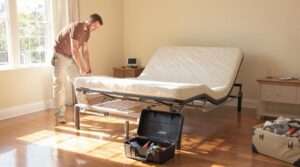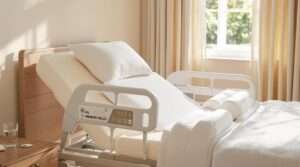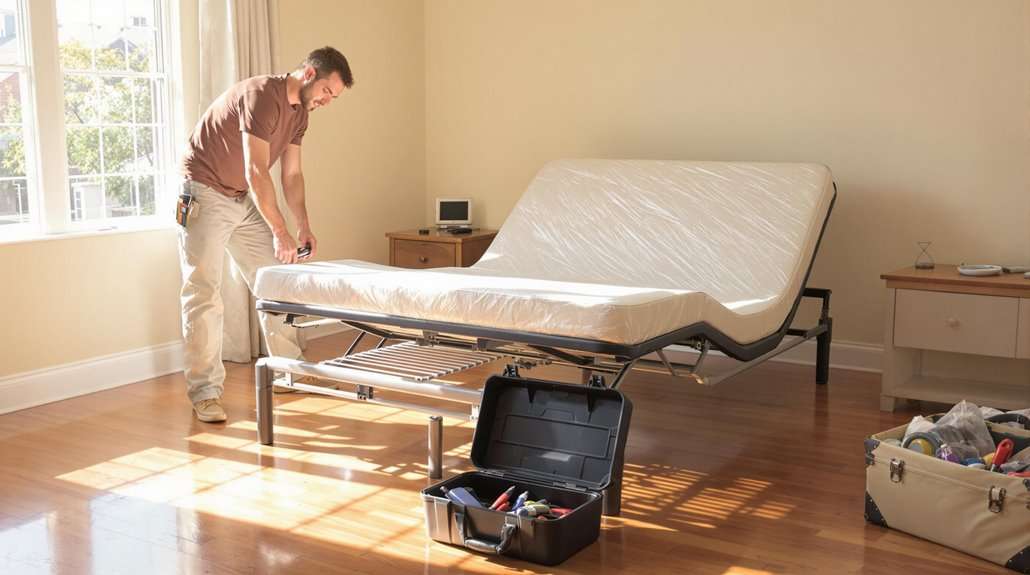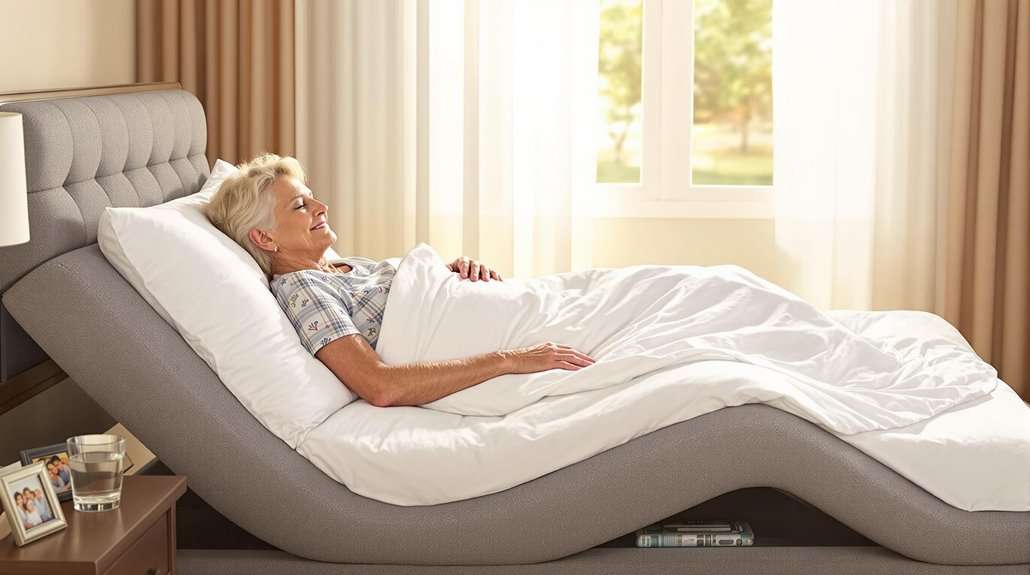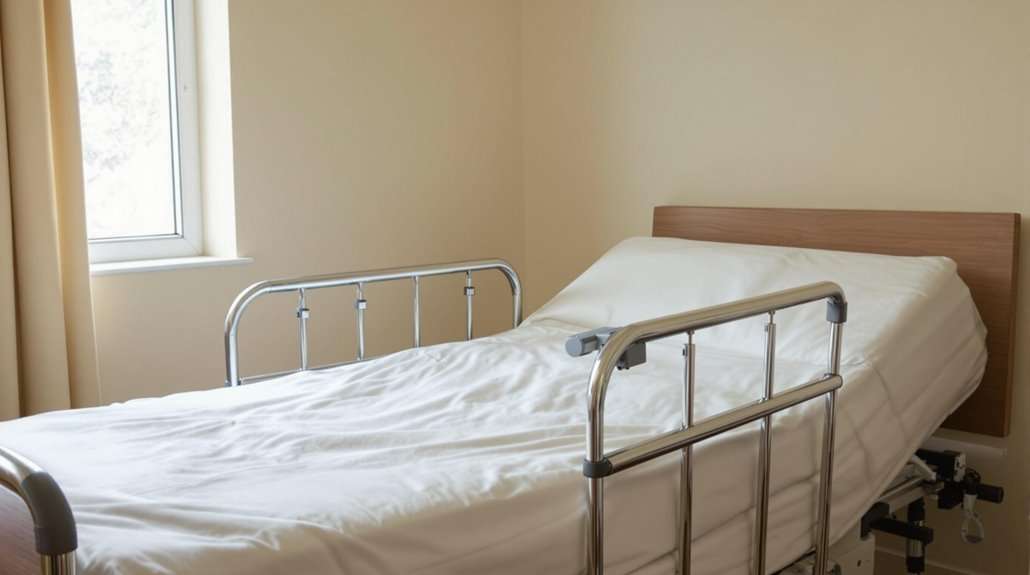Many caregivers worry about what to do if a disaster strikes while caring for a patient at home. Every emergency kit should have basic survival items like water, non-perishable food, and first aid supplies.
This blog will show you simple steps on how to create a home emergency kit for patients using essential survival essentials and medical necessities. Learn the secrets to better preparedness in your home.
📋✅
- Every home emergency kit must include at least three days’ worth of water (one gallon per person per day), non-perishable food, a first aid kit, and a two-week supply of necessary medications for patients.
- Always pack copies of important documents like medical records, health insurance cards, prescription details, and contact information for healthcare providers in waterproof containers.
- Update your emergency kit every few months by checking expiration dates on medications and food, rotating out old items for fresh ones, and keeping a list to restock essential supplies.
- Include special needs items such as insulin, mobility aids, or comfort objects based on the patient’s unique conditions to ensure complete care during emergencies.
- Use trusted resources like Be Prepared California and the Center for Health Care Quality to find checklists and guides that help tailor your kit to patient-specific requirements.
The Importance of Having an Emergency Kit for Patients
Patients rely on specific items for their health and safety. An emergency kit plays a vital role in supporting these needs during disasters. It should include enough water to last three days, one gallon per person per day.
Non-perishable food must also be part of the kit, providing nourishment without complicated preparation. Medications are crucial; having a two-week supply ready can make all the difference.
First aid supplies add another layer of protection. Include items like sterile gloves, dressings, soap, antibiotic towelettes, and ointment for basic care needs. Keeping medical records and contact information for healthcare providers ensures quick access during emergencies.
Creating this emergency kit protects patients and promotes peace of mind for caregivers as they prepare for any unexpected situation that may arise next.
Essential Items to Include in a Home Emergency Kit
You should pack vital supplies to prepare for emergencies. Focus on water, food, first aid materials, and important medications to support those in your care.
Water and non-perishable food
Water and non-perishable food are vital for any home emergency kit. Each person should have one gallon of water per day for three days. This means storing at least nine gallons of clean water for every family member.
Keep in mind that a two-week supply is necessary for use at home.
Include non-perishable, easy-to-prepare food items in your kit. Choose foods like canned goods, granola bars, and dried fruits that need no cooking. Stock enough to last three days.
Having these supplies ensures everyone stays fed during a disaster while also helping manage health needs effectively.
In my experience as a caregiver, having an updated stock of both water and food makes preparations smoother for patients with special requirements. It saves time during stressful moments when you can grab ready-to-eat meals without fussing over cooking or sourcing fresh ingredients later on.
First aid kit
A first aid kit is crucial for any home emergency kit, especially for patients. It should contain sterile gloves, dressings to stop bleeding, soap, antibiotic towelettes, and antibiotic ointment.
Each caregiver must ensure the kit has enough supplies to last at least three days. Include items that cater specifically to the patient’s condition or medication needs.
Packing a first aid kit requires thought and preparation. Stock it with essential medical supplies along with necessary medications. By organizing these items in advance, caregivers can provide immediate support during an emergency or disaster scenario.
A well-prepared first aid kit enhances your ability to care for loved ones when they need it most.
Extra clothing and bedding
After assembling your first aid kit, focus on extra clothing and bedding. These items can provide comfort during emergencies. Pack enough clean clothes for everyone in the household.
Include warm layers like sweaters, socks, and hats. Consider special needs for patients who may require specific types of clothing or fabric.
Bedding is equally important for warmth and rest. Store blankets or sleeping bags to keep family members comfortable. A good setup helps maintain morale during tough times after a disaster.
Make sure to check these items regularly for cleanliness and usability while considering space-saving packaging solutions to fit them easily into your emergency supplies bag.
Personal hygiene items
Personal hygiene items are vital in a home emergency kit. Caregivers should include soap, hand sanitizer, and sanitation items. These supplies help maintain cleanliness during stressful situations.
Sterile gloves also belong in the kit as they protect both patients and caregivers during medical emergencies.
Extra personal hygiene products ensure comfort for patients after a disaster strikes. Items like toothbrushes, toothpaste, sanitary wipes, and toilet paper keep everyone feeling fresh.
An emergency kit needs to cover all basic needs to support patient care effectively.
Medications and medical supplies
Medications and medical supplies are vital components of a home emergency kit for patients. Include enough medications to last at least two weeks. Make sure to pack prescriptions needed daily.
Add over-the-counter pain relievers, allergy medications, and any other essential drugs.
Include medical supplies such as sterile gloves, dressings to stop bleeding, and antibiotic ointment in the kit. Do not forget soap and antibiotic towelettes for cleanliness. Keep copies of important medical records with contact information for healthcare providers in your kit.
Tailor these items based on individual health needs or conditions for better preparedness during emergencies.
Copies of important documents
After gathering medications and medical supplies, caregivers should focus on copies of important documents. This includes essential papers like medical records and contact information for healthcare providers.
Keep these documents in a waterproof bag to protect them during emergencies.
Having access to vital information can help you provide the best care. Gather health insurance cards, identification, and prescription details as well. An organized kit supports your efforts in disaster preparedness by ensuring everything is ready at hand when needed most.
Special needs items
Special needs items are crucial for patients with specific requirements. These may include medical supplies like insulin, nebulizers, or specialized feeding equipment. Ensure you have enough medications in your emergency kit to last at least two weeks.
Keep copies of important medical records and contact information for healthcare providers nearby.
You should also consider including comfort items that help patients cope during emergencies. Blankets, mobility aids, or favorite toys can provide emotional support when stress levels rise.
Be prepared by taking inventory of any extra tools your patient might need to stay safe and healthy during a disaster or evacuation event. Prioritize these special needs items when creating a home emergency kit for maximum readiness and care.
Tips for Maintaining Your Emergency Kit
Check your emergency kit regularly. Make sure products are fresh and not expired.
Regularly check expiration dates
Regularly checking expiration dates keeps your emergency kit effective. Medications and medical supplies lose their potency after they expire. This can endanger a patient’s health during an emergency.
Establish a routine to inspect these items every few months. Discard any expired products promptly, and replace them with fresh supplies.
Include enough medications for at least two weeks in your kit. Make sure to store them properly, so they stay safe and usable. Keep a list of what you have on hand and note the expiration dates next to each item.
This approach helps you maintain your home emergency kit for patients efficiently while ensuring essential medical equipment remains reliable when needed most.
Rotate out items for freshness
Check the expiration dates on all items in your home emergency kit. Replace any expired medications, food, or supplies to ensure their effectiveness. Non-perishable foods can spoil over time if not stored correctly.
Choose easy-to-prepare options for quick meals during a disaster.
Keep your emergency supplies fresh by regularly reviewing and replacing them as needed. Make it a habit to add new items while taking out old ones; this helps maintain a ready supply for emergencies but also ensures you have what patients require at any moment.
Stock your grab-and-go bag with snacks and water that won’t go stale quickly; aim for freshness and usability in every item included in the kit.
Keep a list of necessary items to restock
Keeping a list of necessary items to restock is crucial for caregivers. This list helps you track supplies in your home emergency kit. Make sure it includes essential items such as water, non-perishable food, and medications.
A well-organized list simplifies the process of checking expiration dates on food and medical supplies regularly.
You should aim for at least three days’ worth of each supply type as part of disaster preparedness. Replace any stale or expired foods quickly to maintain freshness. This proactive approach ensures that your emergency kit remains ready when every minute counts during an evacuation or disaster scenario.
Additional Resources for Emergency Preparedness
You can find valuable information on emergency preparedness from various websites and guides. These resources offer insights into disaster planning, health management, and safety checklists to help caregivers stay informed.
Be Prepared California website
Be Prepared California offers vital resources for emergency preparedness. This website helps caregivers and families understand how to build an effective home emergency kit for patients.
It emphasizes the importance of having essential items like water, food, and medications ready in case of a disaster. A basic survival kit should include enough supplies to last at least three days.
Caregivers can find guidance on necessary medical equipment tailored to specific needs under the resources section. The site also provides safety checklists that detail other important items, such as first aid kits and copies of crucial documents.
By using these tools, caregivers can ensure their loved ones remain safe during emergencies and disasters.
Know and Understand Natural Disasters guide
Natural disasters can strike suddenly and without warning. Caregivers must understand these events to protect patients effectively. The “Know and Understand Natural Disasters” guide offers essential information about different types of disasters, including floods, earthquakes, and hurricanes.
This knowledge helps you prepare for potential emergencies.
Every home emergency kit should include vital supplies like water storage, non-perishable food, and an appropriate first aid kit. Ensure your kit has enough items to last at least three days for each person in the household.
Additionally, have a grab-and-go bag ready with necessities such as medications, communication devices, and personal hygiene items to facilitate quick evacuation if needed.
Center for Family Health resources
Following the Know and Understand Natural Disasters guide, caregivers can benefit from the Center for Family Health resources. This center provides vital information about emergency preparedness and health care options.
They offer guidance on how to create a home emergency kit specifically for patients.
Resources include tips on medication storage and access to medical supplies during crises. Caregivers will find detailed advice tailored for patient needs. The center helps families understand what essential items are necessary for survival after a disaster, such as water, non-perishable food, first aid kits, and medications.
Utilizing these resources ensures that caregivers can support their patients effectively during emergencies.
Center for Health Care Quality resources
The Center for Health Care Quality offers vital support for caregivers preparing home emergency kits. This organization provides guidance tailored to patient needs, emphasizing the importance of necessary medical supplies and equipment.
They highlight that each emergency kit should include specific medications, medical records, and contact information for healthcare providers.
Caregivers can rely on these resources to ensure their emergency kits contain essential items like sterile gloves, dressings to stop bleeding, and antibiotic ointment. The Center helps families understand how to assemble an effective survival kit with adequate water and food supplies for at least three days.
By utilizing these resources, caregivers can enhance disaster preparedness in a meaningful way.
Office of Communications resources
Caregivers need reliable information about emergency preparedness. The Office of Communications offers valuable resources to help with this task. They provide guidance on creating a home emergency kit that caters to specific patient needs.
Essential items like medical supplies and important documents are covered in their materials.
These resources include insights on communication devices and evacuation plans. Caregivers can access tips for improving disaster preparedness at home or during travel. Knowing how to access these tools gives caregivers peace of mind as they support patients through unexpected events.
Resources from the Office of Communications also emphasize the importance of having an emergency plan ready, ensuring safety for everyone involved.
Creating a home emergency kit for patients is crucial. Gather essential items to ensure their safety during a disaster. Regularly check and update the supplies to keep everything fresh and ready.
Tailor the kit to meet specific medical needs, including medications and records. With these steps, you can help protect your loved ones when it matters most.
FAQs
1. What are the most important emergency supplies for a home kit for patients?
A home emergency kit should include water, nonperishable food, a first aid kit, shelter items, and power sources. These survival essentials help with disaster preparedness.
2. How much water and food should I store in my emergency resources?
Store at least one gallon of water per person per day for three days. Keep enough nonperishable food to last each person three days as part of your disaster supplies.
3. Why is an evacuation plan needed in a home emergency kit?
An evacuation plan helps everyone know what to do if you must leave quickly during a disaster. It keeps patients safe and connects them with other emergency resources.
4. What communication devices should be included in an emergency supply kit?
Include battery-powered radios, extra phone chargers, or backup phones to stay informed during emergencies when regular power sources may fail.
5. How can first aid kits support patient survival during disasters?
First aid kits provide basic care until professional help arrives; they contain medical tools and supplies vital for treating injuries or sudden illnesses during emergencies.



